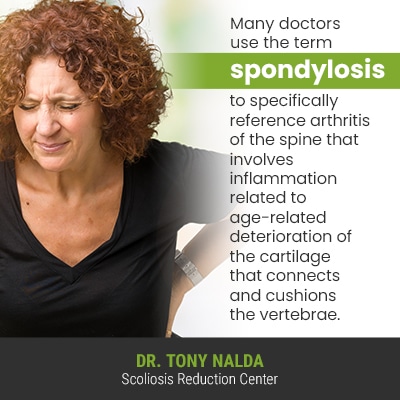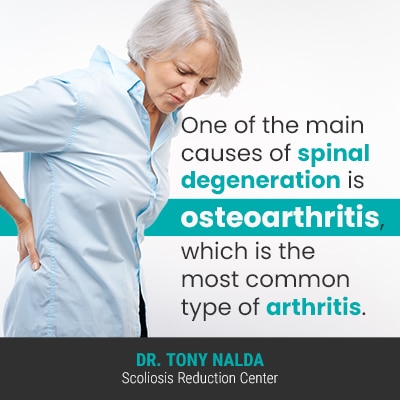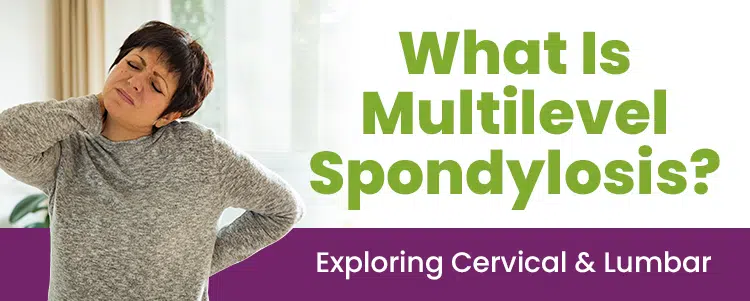Spondylosis is an umbrella term that references pain caused by degenerative spinal conditions; it’s not a clinical diagnosis and is commonly caused by arthritis. Multilevel spondylosis involves spinal degeneration on multiple levels/segments of the spine: cervical, thoracic, and/or lumbar.
Lumbar spondylosis can lead to nerve compression, which often results in leg pain. This pain, known as lumbar radiculopathy, can radiate down the leg and is sometimes mistaken for isolated injuries. Understanding how spinal health directly influences leg pain and discomfort is crucial.
In severe cases of multilevel spondylosis, particularly when it affects the thoracic spine and leads to spinal stenosis, spinal surgery may be necessary to alleviate pain and restore function.
Let’s start our exploration of multilevel spondylosis by first touching on the different sections of the spine.
Levels of the Spinal Cord
The spine is made up of vertebrae (bones) that are rectangular in shape and stacked on top of one another in a straight alignment.
The vertebrae are separated by intervertebral discs, which are important spinal structures for a number of reasons: providing the spine with structure (adjacent vertebrae attach to the disc in between), making the spine more flexible, providing cushioning between adjacent vertebrae, and acting as shock absorbers.
The discs are important in the context of spondylosis because many forms of spinal degeneration start with changes to the intervertebral discs.
If an intervertebral disc starts to deteriorate and becomes desiccated, bulging, or herniated, the spine’s structure is compromised as it becomes harder to maintain its natural curvatures and alignment.
The spine’s natural curvatures make it stronger, more flexible, and better able to absorb/distribute mechanical stress; many types of spinal degeneration affect the spine’s ability to maintain its natural curvatures and alignment.
The spine is made up of three main sections (levels): cervical (neck), thoracic (upper/middle back), and lumbar (lower back).
The cervical spine consists of 7 vertebrae, the thoracic spine has 12, and the lumbar spine consists of 5.
The optimal health and function of each of these spinal sections is dependent on the health of the others, which is why spinal degeneration in one section can affect the integrity of other levels of the spine.
So now that we have a basic idea of the different cervical, thoracic, and lumbar levels of the spine, let’s address the term lumbar spondylosis. Nerve compression caused by spinal degeneration in the lumbar spine can lead to leg pain, affecting the overall integrity and function of the spine. Understanding how conditions like lumbar radiculopathy can cause pain that radiates down the leg is crucial for comprehending the full impact of spinal health on leg pain and discomfort.
Definition and Description
Cervical spondylosis is a common condition that primarily affects the neck, especially in older adults. It is a type of spinal osteoarthritis that occurs when the joints and discs in the cervical spine wear down over time. This degeneration can lead to the formation of bone spurs, herniated discs, and other degenerative changes. Individuals with cervical spondylosis often experience neck pain, stiffness, and limited mobility. Additionally, the condition can cause numbness, tingling, and weakness in the arms and hands, making everyday activities challenging.
What is Multilevel Cervical Spondylosis?
As mentioned, spondylosis is a general term that references pain caused by a variety of spinal conditions/issues related to degenerative changes in the spine itself.
Multilevel spondylosis refers to the presence of spondylotic changes in both the cervical and lumbar regions of the spine, characterized by conditions like cervical osteophytic stress, endplate spurring, and bone spurs. This condition can lead to symptoms such as neck pain and spinal cord compression, sometimes necessitating spine surgery to alleviate the effects of mild anterior spondylosis and mild lumbar spondylosis on the spinal canal and spinal cord. When moderate spondylosis affects areas such as the thoracic spine and leads to spinal stenosis, spinal surgery may be necessary to alleviate pain and restore function.

Many doctors use the term spondylosis to specifically reference arthritis of the spine that involves inflammation related to age-related deterioration of the cartilage that connects and cushions the vertebrae.
Spondylosis can affect one section, if the vertebral bodies experiencing degeneration are isolated to one level of the spine, or the affected vertebrae can be located in multiple sections: multilevel spondylosis.
In addition, multilevel spondylosis can also refer to instances where multiple vertebrae within one section are affected.
Cervical spondylosis and lumbar spondylosis are the most common because the vertebrae of the lower back support the weight of the spine and trunk, while the vertebrae of the cervical spine have to support the weight of the neck and head: something that’s become increasingly difficult in the modern age with the prevalence of forward head posture, also known as tech neck.
The vertebrae of the spine that are responsible for supporting the most weight are generally the first to experience degenerative changes, either due to natural age-related deterioration, the cumulative effect of certain lifestyle choices, and/or degenerative spinal conditions.
Multilevel spondylosis, whether affecting the cervical or lumbar spine, involves degenerative changes in multiple spinal levels, which can include conditions such as C5-C6 disc bulging and may even coexist with levoconvex scoliosis, leading to complex spinal issues that require careful evaluation and management.
So what is multilevel degenerative spondylosis?
What is Multilevel Degenerative Lumbar Spondylosis?
Multilevel degenerative spondylosis means that multiple spinal levels/vertebrae are experiencing degenerative changes, and this can be a more severe form of spondylosis because of the extent of spinal degeneration and the severity of back, neck, and/or radicular pain it can cause. It can also be compared to multilevel degenerative disc disease.
There are a number of causes for spinal degeneration, so let’s touch on some of the most common: aging, lifestyle, and arthritis.
Multilevel spondylosis, a form of degenerative disc disease, affects various regions of the spine, including mid-cervical spondylosis and moderate thoracic spondylosis, often leading to bone spurs and cervical osteophytes that can cause radiating pain by compressing spinal nerves.
Aging and Lifestyle
There is a certain amount of natural age-related spinal degeneration to be expected, but lifestyle choices can reduce or increase those levels.
Carrying excess weight means more pressure and weight for the joints of the body, including the spine, to support, and this increases general wear and tear on the spine over time.
Leading a sedentary lifestyle is contrary to the spine’s movement-based design, and particularly for the intervertebral discs, good surrounding circulation is the means by which they hydrate and absorb nutrients, so regular movement is key.
Chronic poor posture can lead to the development of a number of spinal issues/conditions, including increasing degeneration, as holding the spine in an unnatural position can strain the vertebrae and the surrounding spinal muscles; over time, this can have the cumulative effect of changing the position of vertebrae and weakening muscles as they struggle to support and stabilize the spine in its unnatural position.
Repeatedly lifting heavy objects incorrectly can also cause spinal degeneration by introducing adverse spinal tension, strain, and increasing risk of injury.
The aforementioned types of lifestyle choices can have a cumulative effect of increasing wear and tear on the spine, and this can speed up natural age-related spinal deterioration, and impact its overall health and function.
Intervertebral Disc Issues
As mentioned, it’s often the spinal discs that are at the root of degenerative changes, with issues such as degenerative disc disease-causing and disc desiccation structural changes to the spine: shifting the position of affected vertebrae so the spine is no longer aligned and functioning optimally.

One of the main causes of spinal degeneration is osteoarthritis, which is the most common type of arthritis.
Osteoarthritis
Osteoarthritis affects millions of people around the world and involves the loss of protective cartilage that cushions bones where they meet (joints); cartilage is the elastic tissue that protects joints from friction/wear and tear, and facilitates optimal normal joint function by providing lubrication.
In spinal osteoarthritis, the facet joints are targeted, and this means the spinal discs and vertebrae aren’t being cushioned and protected and rub up against one another, causing inflammation, friction, and degeneration.
Degenerative disc disease also plays a role in osteoarthritis, which is why they commonly present together.
The intervertebral discs are primarily made of water, and over time, their fluid level decreases (desiccation), and this causes the discs to change shape and lose height; their change in position puts extra pressure on the facet joints, and this can lead to a loss of cartilage over time and the development of osteoarthritis of the spine.
The problem with disc and joint degeneration is that while certain steps can be taken to slow degenerative changes, once deterioration has occurred, it’s a long process to work towards reversing some of that damage, and of course, there are no guarantees.
Particularly the spinal discs, as they don’t have their own vascular supply, are limited in how much they can repair themselves.
The spine plays many important roles in human anatomy; it helps us to stand upright and practice good posture, engage in flexible movement, support the weight of the torso, and absorb mechanical stress.
As such a key structure, the spine is made up of many moving parts such as its vertebrae, facet joints, and intervertebral discs.
In a healthy spine, the vertebrae are stacked on top of one another in a straight alignment and are separated by intervertebral discs that provide essential cushioning that protects the joints of the spine.
If the vertebrae or discs start to deteriorate, they affect the biomechanics of the entire spine by impacting its ability to maintain its natural curvatures and alignment.
A spine that is misaligned and/or has lost one or more of its healthy curves can’t function optimally, and this will increase spinal degeneration and can cause the development of spondylosis.
Spondylosis is not a spinal condition, but rather a term that references symptoms of back, neck, and/or radicular pain caused by deterioration of the spine and its parts.
Spinal degeneration is caused by natural age-related changes, particularly in women going through menopause and experiencing changes in hormones and bone density, the cumulative effect of certain lifestyle choices, and osteoarthritis of the spine that causes a loss of facet-joint cartilage, resulting in inflammation, friction, and degeneration.
Spondylosis can affect one section of the spine, or multiple levels and segments: multilevel spondylosis.
Cervical and lumbar spondylosis affect the neck and lower back, and these are the most common regions affected as the vertebrae of the lower back have to support the weight of the spine and trunk, and the vertebrae of the cervical spine have to support the weight of the neck and head.
Here at the Scoliosis Reduction Center®, I treat multilevel spondylosis by customizing treatment plans based on the condition’s underlying cause and combining different treatment disciplines for the most specific results.
While there are no treatment guarantees, by combining condition-specific chiropractic care, in-office therapy, custom-prescribed home exercises, and bracing when necessary, I can help restore as much of the spine’s healthy curves, alignment, function, which can prevent further spinal degeneration, or at the very least, slow down the process.
Causes and Risk Factors
Cervical spondylosis is primarily caused by the natural wear and tear of the cervical spine as we age. Over time, the discs and joints in the neck can deteriorate, leading to degenerative changes. Several risk factors can increase the likelihood of developing cervical spondylosis:
- Genetics: Some individuals may be genetically predisposed to developing cervical spondylosis.
- Lifestyle: Occupations or activities that involve prolonged periods of looking up or down, such as construction work or extensive computer use, can contribute to the development of cervical spondylosis.
- Trauma: A history of neck injuries or trauma can elevate the risk of cervical spondylosis.
- Obesity: Carrying excess weight can place additional strain on the neck and spine, accelerating the wear and tear process.
Symptoms
The symptoms of cervical spondylosis can vary widely depending on the severity of the condition. Common symptoms include:
- Neck pain or stiffness
- Limited mobility in the neck
- Numbness, tingling, or weakness in the arms and hands
- Headaches
- Dizziness or loss of balance
- Pain or numbness in the legs
These symptoms can significantly impact an individual’s quality of life, making it essential to seek medical attention if they persist.
Diagnosis and Testing
Diagnosing cervical spondylosis typically involves a combination of physical examination, medical history review, and imaging tests. These tests help to assess the extent of degenerative changes and identify any nerve root involvement. Common imaging tests include:
- X-rays: These are used to evaluate the alignment and structure of the cervical spine.
- MRI: This imaging test provides detailed images of the discs, joints, and nerve roots in the cervical spine.
- CT scans: These scans offer a closer look at the bones and joints in the cervical spine, helping to identify any structural abnormalities.
Treatment Options
Treatment for cervical spondylosis often involves a combination of conservative measures and physical therapy. Conservative treatments may include:
- Pain medication: To manage pain and reduce inflammation.
- Physical therapy: To improve mobility and strengthen the neck and shoulder muscles.
- Lifestyle modifications: To minimize strain on the neck and spine, such as ergonomic adjustments and posture correction.
In more severe cases, surgical intervention may be necessary to relieve pressure on the spinal cord or nerve roots. Surgical options include:
- Discectomy: Removal of a herniated disc to alleviate nerve compression.
- Laminectomy: Removal of a portion of the vertebra to relieve pressure on the spinal cord.
- Fusion surgery: Fusing two or more vertebrae together to stabilize the spine.
It is crucial to consult with a healthcare provider to determine the most appropriate treatment plan for cervical spondylosis, tailored to the individual’s specific condition and needs.
Scoliosis vs. Spondylosis
While both scoliosis and spondylosis involve the spine, they are distinct conditions. Scoliosis is a sideways curvature of the spine, often developing during adolescence, while spondylosis is a type of degenerative change caused by age or wear and tear. Scoliosis affects spinal alignment, potentially causing symptoms like uneven shoulders or hips, while spondylosis leads to the degeneration of vertebrae, discs, and joints, often resulting in pain and stiffness.
Spondylosis vs. Spondylolysis
Spondylosis and spondylolysis are often confused due to their similar names, but they refer to different spinal conditions. Spondylosis describes degenerative changes in the spine, typically related to aging. In contrast, spondylolysis refers to a stress fracture in a vertebra, typically seen in younger individuals, especially athletes. While spondylosis involves general wear and tear, spondylolysis is a specific structural defect in the spine.




